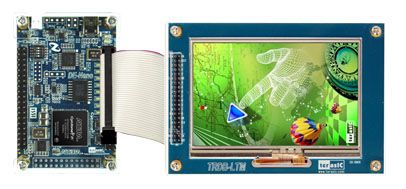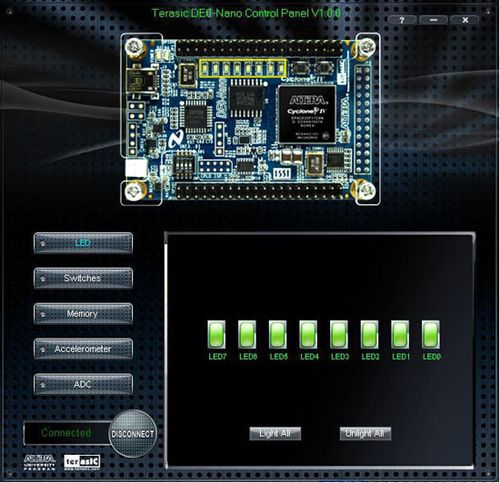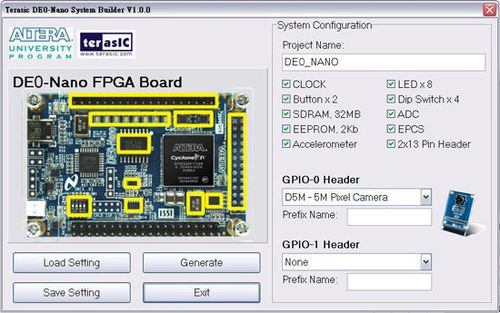![Terasic DE0-Nano [EDU] - zestaw startowy z układem FPGA z rodziny Cyclone IV firmy Altera Terasic DE0-Nano [EDU] - zestaw startowy z układem FPGA z rodziny Cyclone IV firmy Altera](https://kamami.pl/4338-large_default/terasic-de0-nano-p0082-edu.jpg)
![Terasic DE0-Nano [EDU] - zestaw startowy z układem FPGA z rodziny Cyclone IV firmy Altera Terasic DE0-Nano [EDU] - zestaw startowy z układem FPGA z rodziny Cyclone IV firmy Altera](https://kamami.pl/4338-large_default/terasic-de0-nano-p0082-edu.jpg)
![Terasic DE0-Nano [EDU] - zestaw startowy z układem FPGA z rodziny Cyclone IV firmy Altera Terasic DE0-Nano [EDU] - zestaw startowy z układem FPGA z rodziny Cyclone IV firmy Altera](https://kamami.pl/4338-large_default/terasic-de0-nano-p0082-edu.jpg)
![Terasic DE0-Nano [EDU] - zestaw startowy z układem FPGA z rodziny Cyclone IV firmy Altera Terasic DE0-Nano [EDU] - zestaw startowy z układem FPGA z rodziny Cyclone IV firmy Altera](https://kamami.pl/4338-small_default/terasic-de0-nano-p0082-edu.jpg)
zł460.80 tax excl.
Altera DE0 NANO Development and Education Board introduces a compact-sized FPGA development platform suited for prototyping circuit designs such as robots and "portable" projects. The board is designed to be used in the simplest possible implementation targeting the Cyclone IV device up to 22,320 LEs.

ATTENTION! This product is for academic recipients (students and academic teachers) only!
After the ordering, please send us by e-mail the data listed below:
- the name and last name
- position (student, teacher)
- e-mail (with the University domain)
- University name
- Facultie / Section
- University address
- University phone no.
- End user application
The DE0-Nano board introduces a compact-sized FPGA development platform suited for prototyping circuit designs such as robots and "portable" projects. The board is designed to be used in the simplest possible implementation targeting the Cyclone IV device up to 22,320 LEs.
The DE0-Nano has a collection of interfaces including two external GPIO headers to extend designs beyond the DE0-Nano board, on-board memory devices including SDRAM and EEPROM for larger data storage and frame buffering, as well as general user peripheral with LEDs and push-buttons.
The advantages of the DE0-Nano board include its size and weight, as well as its ability to be reconfigured without carrying superfluous hardware, setting itself apart from other general purpose development boards. In addition, for mobile designs where portable power is crucial, the DE0-Nano provides designers with three power scheme options including a USB mini-AB port, 2-pin external power header and two DC 5V pins.
Cyclone® IV EP4CE22F17C6N FPGA
- 22,320 Logic elements (LEs)
- 594 Embedded memory (Kbits)
- 66 Embedded 18 x 18 multipliers
- 4 General-purpose PLLs
- 153 Maximum FPGA I/O pins
Configuration Status and Set-Up Elements
- On-board USB-Blaster circuit for programming
- Altera serial configuration device – EPCS16
Expansion Header
- Two 40-pin Headers (GPIOs) provides 72 I/O pins
- Two 5V power pins, two 3.3V power pins and four ground pins
- One 26-pin header provides 16 digital I/O pins and 8 analog input pins to connect to analog sensors, etc
Memory Devices
- 32MB SDRAM
- 2Kb I2C EEPROM
General User Input/Output
- 8 green LEDs
- 2 debounced push-buttons
- 4 dip switches
G-Sensor
- ADI ADXL345, 3-axis accelerometer with high resolution (13-bit)
A/D Converter
NS ADC128S022, 8-Channel, 12-bit A/D Converter
50 ksps to 200 ksps
Clock System
On-board 50MHz clock oscillator
Power Supply
Connectivity:
Connect D5M
- Connect with 5-megapixel CMOS Sensor (D5M)
Connect LTM
- Connect with LCD Touch Screen Module (LTM)

Connect THDB-ADA
- Connect with Analog to Digital/Digital to Analog Conversion Daughter Card (THDB-ADA)
Layout
DE0-Nano Control Panel

DE0-Nano System Builder

Kit Contents
The DE0-Nano package includes:
Manufacturer BTC Korporacja sp. z o. o. Lwowska 5 05-120 Legionowo Poland sprzedaz@kamami.pl 22 767 36 20
Responsible person BTC Korporacja sp. z o. o. Lwowska 5 05-120 Legionowo Poland sprzedaz@kamami.pl 22 767 36 20
TerasIC DE0 is a complete evaluation kit based on the Cyclone III FPGA, designed for learning, testing, and implementing digital systems. It offers a wide range of interfaces and peripherals enabling the creation of complex projects for both educational and industrial purposes.
No product available!
[EDUCATIONAL PRICE] Terasic DE0 Board evaluation kit for Altera Cyclone III FPGA devices. It is equipped with all basic peripherals enabling research and evaluation work with FPGAs, including a JTAG programmer-configurator. The reduced price (compared to the standard Terasic DE0 version) applies exclusively to schools, universities, lecturers, pupils, and students.
No product available!
Altera DE0 NANO Development and Education Board introduces a compact-sized FPGA development platform suited for prototyping circuit designs such as robots and "portable" projects. The board is designed to be used in the simplest possible implementation targeting the Cyclone IV device up to 22,320 LEs.
The Terasic LT24 is a 2.4” LCD touch module with 240(H) x 320(V) display resolution. It can be bundled with various Terasic FPGA development boards through the 2x20 GPIO interface. P0185
TerasIC XTS-HSMC is an expansion card for FPGA platforms with transceivers, enabling signal conversion to SMA connectors and rapid prototyping of high-throughput interfaces. It is useful in compliance testing, transmission quality evaluation, and projects requiring reliable data transfer at gigabit speeds.
No product available!
The DE10-Standard Development Kit presents a robust hardware design platform built around the Intel System-on-Chip (SoC) FPGA, which combines the latest dual-core Cortex-A9 embedded cores with industry-leading programmable logic for ultimate design flexibility. P0493
No product available!
Compact FPGA kit with Intel Arria 10 GX chip equipped with 8 GB DDR4-2133 memory and Thunderbolt 3 communication connector. Can be used directly on laptops or other portable devices. Terasic FLIK P0642
No product available!
Evaluation board with an Intel Agilex SoC featuring 1.4 million logic elements. The module includes sockets with built-in 32 GB DDR4 SO-DIMM memory, a QSFP28 connector, PCIe Gen 4x16, an integrated USB-Blaster II, and FMC/FMC+ connectors for expansion. TerasIC Apollo Agilex SOM (P0795)
No product available!
MAX 10 10M50DAF484C6G with 50K LEs, DDR3 with ECC, QSPI Flash, MicroSD Card, Ethernet, Audio codec, HDMI RX, Acceleromter, ADC, DAC, 8-Mega pixel color camera and 7" 5-point touch screen. P0800
No product available!
FPGA starter kit with Intel Stratix 10 SX chip. The module has integrated transceivers that transmit data at speeds up to 28.3 Gb/s, making DE10-Pro fully compatible with version 3.0 of the PCI Express standard. The DE10-Pro offers fast parallel Flash memory and four SO-DIMMs that have 8GB DDR4 SDRAM. Terasic P0629
No product available!
TerasIC USB Blaster Download Cable (UBT) is a fully Altera USB Blaster–compatible JTAG/ISP programmer for CPLD and FPGA devices. With a reliable design and resistance to interference, it is a universal tool for designers working with Altera programmable devices. TerasIC P0302
TerasIC SODIMM memory module with 18MB capacity and 550MHz operating frequency. The module is designed to work with Intel Stratix 10 FPGAs in evaluation kits such as TerasIC DE10-Pro-GX-280-4G and TerasIC DE10-Pro-GX-280-8G. TerasIC S0534
No product available!
TerasIC NET is an HSMC-standard Ethernet module enabling rapid implementation of network communication in FPGA systems. With support for speeds from 10 Mb/s to 1 Gb/s and full integration with FPGA devices, it is a convenient tool for designing applications that require reliable network communication.
No product available!
A set of elements designed for evaluation sets with programmable circuits of the Cyclone V SoC FPGA family, which includes; 7-inch TFT display with touch support (5-points), 8 megapixel camera with autofocus and sensors (light, accelerometer, gyroscope, magnetometer). Terasic P0494
No product available!
The robot can recognize the attitude in real time using an acceleration and gyroscope sensor, as well as achieve balance by controlling the motors to adjust the position. Terasic P0582
No product available!
Gigabit Ethernet transceiver with an FMC interface. Up to 1 Gbps network transfers with the host board using an FMC connector. NET-FMC can be connected any FMC(HPC) interfaces. Terasic P0481
No product available!
TerasIC XSFP/SFP+HSMC (P0092) enables the development of 10G Ethernet systems based on the XAUI interface, featuring two SFP+ channels and a 156.25 MHz reference clock. Designed for integration with FPGA boards equipped with an HSMC connector — including Stratix IV GX and DE4 — the module is used in networking projects, data transmission applications, and high-throughput interface testing.
No product available!
Terasic Atum A5 Development Kit – an advanced Intel Agilex 5 FPGA kit for AI, vision systems, and high-bandwidth applications. Terasic Atum A5 Development Kit
No product available!
The ADC-SoC is a SoC FPGA motherboard with dual-channel high-speed ADC
No product available!
Programmable Logic IC Development Tools Cyclone V SE 5CSEMA4U23C6N + 800MHz Dual-core ARM Cortex-A9 processor. Terasic P0496
![Terasic DE0-Nano [EDU] - zestaw startowy z układem FPGA z rodziny Cyclone IV firmy Altera Terasic DE0-Nano [EDU] - zestaw startowy z układem FPGA z rodziny Cyclone IV firmy Altera](https://kamami.pl/4338-large_default/terasic-de0-nano-p0082-edu.jpg)
Altera DE0 NANO Development and Education Board introduces a compact-sized FPGA development platform suited for prototyping circuit designs such as robots and "portable" projects. The board is designed to be used in the simplest possible implementation targeting the Cyclone IV device up to 22,320 LEs.
